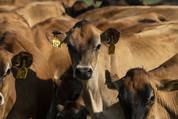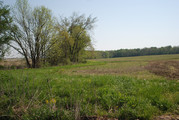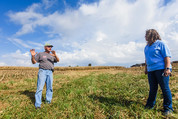
June is dairy month! So it’s a very important month here in New York where dairy is our largest agriculture commodity, so make sure you celebrate every day with a glass of milk, cup of yogurt, bowl of ice cream or a slice of cheese! FSA offers a variety of programs to support dairy producers including our Farm Loan Programs, Dairy Margin Coverage Program, Farm Storage Facility Loans, Marketing Assistance Loans, as well as our latest program specifically for organic dairy operations called the Organic Dairy Marketing Assistance Program (ODMAP). Current certified organic producers need to contact their local office by July 26th to apply for this payment.
Thankfully this week rain is falling across the state after a month of dry weather. One nice thing is we had plenty of dry weather for planting and making hay this spring. Therefore there’s no reason to be late reporting your acreage to your local FSA office by July 17. Speaking of weather, if you experienced damage from the late May freeze event, or any other weather event, make sure to report that to your local FSA office asap!
Two more deadlines approaching are for the Emergency Relief Program (ERP) and Pandemic Assistance Revenue Program (PARP) on July 14. The FSA Administrator recently announced changes to the ERP program which could be beneficial for New York Farmers. This technical correction addresses unintended gaps in assistance to provide a method for valuing losses and obtaining program benefits to eligible producers of certain crops, including grapes grown and used by the same producer to produce wine and forage that is grown, stored, and fed to livestock, that do not generate revenue for a producer directly from the sale of the crop. This updated ERP policy allows producers of certain crops to include a value for the crop in their allowable gross revenue for the purpose of determining ERP benefits. By doing so, ERP benefits are more reflective of these producers’ actual crop losses due to 2020 and 2021 natural disaster events. Updated applications will be available Friday, June 16.
Here's hoping summer will be a nice balance of rainy and sunny days.
All the best,
Jim Barber
New York State Executive Director (SED)
|

USDA announced assistance for dairy producers with the new Organic Dairy Marketing Assistance Program (ODMAP). ODMAP is established to help mitigate market volatility, higher input and transportation costs, and unstable feed supply and prices that have created unique hardships in the organic dairy industry. Specifically, under the ODMAP, USDA’s Farm Service Agency (FSA) is making $104 million available to organic dairy operations to assist with projected marketing costs in 2023, calculated using their marketing costs in 2022. FSA began accepting applications for ODMAP on May 24, 2023. Eligible producers include certified organic dairy operations that produce milk from cows, goats and sheep.
How ODMAP Works
FSA is providing financial assistance for a producer’s projected marketing costs in 2023 based on their 2022 costs. ODMAP provides a one-time cost-share payment based on marketing costs on pounds of organic milk marketed in the 2022 calendar year. ODMAP provides financial assistance that will immediately support certified organic dairy operations during 2023 keeping organic dairy operations sustainable until markets return to more normal conditions.
How to Apply
FSA is accepting applications from May 24 to July 26, 2023. To apply, producers should contact FSA at their local USDA Service Center. To complete the ODMAP application, producers must certify to pounds of 2022 milk production, show documentation of their organic certification, and submit a completed application form.
Organic dairy operations are required to provide their USDA certification of organic status confirming operation as an organic dairy in 2023 and 2022 along with the certification of 2022 milk production in hundredweight.
ODMAP complements other assistance available to dairy producers, including Dairy Margin Coverage (DMC) and Supplemental DMC, with more than $300 million in benefits paid for the 2023 program year to date. Learn more on the FSA Dairy Programs webpage.
|

The U.S. Department of Agriculture (USDA) is updating the Emergency Relief Program (ERP) Phase Two to provide a method for valuing losses and accessing program benefits to eligible producers of certain crops, including grapes grown and used by the same producer for wine production or forage that is grown, stored and fed to livestock, that do not generate revenue directly from the sale of the crop. These updates ensure that ERP benefits are more reflective of these producers’ actual crop losses resulting from 2020 and 2021 natural disaster events. USDA’s Farm Service Agency (FSA) will begin accepting ERP Phase Two applications from eligible wine grape and forage producers once this technical correction to ERP is published in the Federal Register and becomes effective, which it anticipates will be on Friday, June 16, 2023. The deadline to submit applications for ERP Phase Two is July 14.
Background
In January 2023, FSA announced ERP Phase Two, designed to wrap-up and fill remaining gaps in previous natural disaster assistance for 2020 and 2021.
To be eligible for ERP Phase Two, producers must have suffered a decrease in allowable gross revenue in 2020 or 2021 due to necessary expenses related to losses of eligible crops from a qualifying natural disaster event. Assistance is primarily for producers of crops that were not covered by Federal Crop Insurance or the Noninsured Crop Disaster Assistance Program since crops covered by Federal Crop Insurance and NAP were included in the assistance under ERP Phase One administered in 2022.
Determining Crop Value
Producers of certain crops now have a method for including crop value in their allowable gross revenue for the purpose of determining ERP Phase 2 benefits.
The value of the eligible crop intended for on-farm use will be based on the producer’s actual production of the crop and a price for the crop as determined by FSA’s Deputy Administrator for Farm Programs based on the best available data for each crop such as published crop price data or the average price obtained by other producers in the area. Acceptable, published sources including but are not limited to Federal Crop Insurance Corporation established prices, FSA established National Crop Table prices and National Agricultural Statistic Service prices.
Revenue and pricing guidelines for expected revenue for wine grapes and on-farm forage is available online for producer reference and convenience when applying for ERP Phase Two.
Wine grape and forage producers who have already submitted their ERP Phase Two applications to FSA have the option of revising the application and updating their allowable gross revenue to include crop value if applicable.
Producers of crops grown for on-farm use other than wine grapes and forage may request consideration to use a crop’s value in their allowable gross revenue. Submit requests to RA.FSA.DCWA2.ppb@wdc.usda.gov. FSA’s Deputy Administrator for Farm Programs will review submitted requests.
Additional Technical Corrections – Conservation Programs
In addition to emergency relief policy updates, FSA has also established policy corrections for the Emergency Conservation Program (ECP) and the Emergency Forest Restoration Program (EFRP). The policy correction clarifies that federal payments received for the same practice will be considered duplicative assistance for producers who receive ECP and EFRP program payments. The revised program provisions are related to program updates FSA announced in January that give more farmers, ranchers, and tribes the opportunity to apply for and access programs that support recovery following natural disasters (see January 10, 2023 news release for more information).
ECP and EFRP provide financial and technical assistance to restore conservation practices like fencing, damaged farmland or forests following natural disasters.
More Information
FSA offers an online ERP tool to help producers determine what is considered allowable gross revenue. Producers should contact their local FSA office to make an appointment to apply for ERP Phase Two. Producers should also keep in mind that July 15 is a major deadline to complete acreage reports for most crops. FSA encourages producers to complete the ERP Phase Two application and acreage report during the same office visit. Applications for the Pandemic Assistance Revenue Program, a revenue-based program for losses resulting from the pandemic, can also be completed. For more information, view the ERP Phase Two Fact Sheet, PARP Fact Sheet, the ERP Phase Two-PARP Comparison Fact Sheet, ERP Phase Two application video tutorial, PARP application video tutorial, myth-buster blog or contact your local USDA Service Center.
|
The U.S. Department of Agriculture (USDA) is now accepting nominations for county committee members for elections that will occur later this year. Additionally, USDA’s Farm Service Agency (FSA) is unveiling a new GIS tool to make it easier for producers to participate in the nomination and election processes for county committee members, who make important decisions on how federal farm programs are administered locally.
All nomination forms for the 2023 election must be postmarked or received in the local FSA office by Aug. 1, 2023.
Elections will occur in certain Local Administrative Areas (LAA) for members. LAAs are elective areas for FSA committees in a single county or multi-county jurisdiction and they may include LAAs that are focused on an urban or suburban area.
Customers can locate their LAA through a new GIS locator tool available at fsa.usda.gov/elections.
Agricultural producers may be nominated for candidacy for the county committee if they:
- Participate or cooperate in a USDA program; and
- Reside in the LAA that is up for election this year.
A cooperating producer is someone who has provided information about their farming or ranching operation to FSA, even if they have not applied or received program benefits. Individuals may nominate themselves or others and qualifying organizations may also nominate candidates. USDA encourages minority producers, women and beginning farmers or ranchers to nominate, vote and hold office.
Nationwide, more than 7,700 dedicated members of the agricultural community serve on FSA county committees. The committees are made up of three to 11 members who serve three-year terms. Committee members are vital to how FSA carries out disaster programs, as well as conservation, commodity and price support programs, county office employment and other agricultural issues.
Urban and Suburban County Committees
The 2018 Farm Bill directed USDA to form urban county committees as well as make other advancements related to urban agriculture, including the establishment of the Office of Urban Agriculture and Innovative Production. FSA established county committees specifically focused on urban agriculture. The urban county committees will work to encourage and promote urban, indoor and other emerging agricultural production practices. Additionally, the new county committees may address areas such as food access, community engagement, support of local activities to promote and encourage community compost and food waste reduction.
Urban committee members are nominated and elected to serve by local urban producers in the same jurisdiction. Urban county committee members will provide outreach to ensure urban producers understand USDA programs and serve as the voice of other urban producers and assist in program implementation that support the needs of the growing urban community.
County committees for urban agriculture are located in 17 cities across the U.S. including New York City.
More Information
Producers should contact their local FSA office today to register and find out how to get involved in their county’s election, including if their LAA is up for election this year. To be considered, a producer must be registered and sign an FSA-669A nomination form. Urban farmers should use an FSA-669-A-3 for urban county committees. The form and other information about FSA county committee elections are available at fsa.usda.gov/elections.
Election ballots will be mailed to eligible voters beginning Nov. 6, 2023.

Agriculture Secretary Tom Vilsack announced the U.S. Department of Agriculture (USDA) is accepting more than 1 million acres in this year’s Conservation Reserve Program (CRP) General signup. This is one of several signups that USDA’s Farm Service Agency (FSA) is holding for the program, and these results reflect the recognition the agricultural community give to CRP as a resource for climate-smart agriculture that helps promote plant and animal biodiversity as well as healthier soil. The signup’s results include 455 acres in New York.
While offers for new land in this General CRP signup totaled about 295,000 acres nationwide, producers submitted re-enrollment offers for 891,000 expiring acres, reflecting the successes of participating in CRP longer term. The total number of CRP acres will continue to climb in the coming weeks once FSA accepts acres on the Grassland CRP signup, which closed May 26. Additionally, so far this year, FSA has received 761,000 offered acres for the Continuous CRP signup, for which FSA accepts applications year-round.
The number of accepted acres that are actually enrolled in General CRP will be decided later this year. Participating producers and landowners should also remember that submitting and accepting a CRP offer is the start of the process, and producers still need to develop a conservation plan before enrolling their land on October, 2023. Each year, during the window between offer acceptance and land enrollment, some producers change their mind and ultimately decide not to enroll some accepted acres without penalty.
General CRP Signup
The General CRP Signup 60 ran from February 27 through April 7, 2023.
Through CRP, producers and landowners establish long-term, resource-conserving plant species, such as approved grasses or trees, to control soil erosion, improve soil health and water quality, and enhance wildlife habitat on agricultural land. In addition to the other well-documented benefits, lands enrolled in CRP are playing a key role in climate change mitigation efforts across the country.
In 2021, FSA introduced improvements to the program, which included a new Climate-Smart Practice Incentive to increase carbon sequestration and reduce greenhouse gas emissions. This incentive provides a 3, 5, or 10 percent incentive payment based on the predominant vegetation type for the practices enrolled – from grasses to trees to wetland restoration.
Other CRP Signups
Grassland CRP is a working lands program that helps producers and landowners protect grassland from conversion while enabling haying and grazing activities to continue. Lands enrolled support haying and grazing operations and promotes plant and animal biodiversity. Lands are also protected from being converted to uses other than grassland. This year’s signup for Grassland CRP ran from April 17 through May 26.
Under Continuous CRP, producers and landowners can enroll throughout the year. Offers are automatically accepted provided the producer and land meet the eligibility requirements and the enrollment levels do not exceed the statutory cap. Continuous CRP includes the State Acres for Wildlife Enhancement (SAFE) Initiative, the Farmable Wetlands Program (FWP), and the Conservation Reserve Enhancement Program (CREP). Also available is the Clean Lakes Estuaries and Rivers (CLEAR) initiative. CLEAR30, a signup opportunity under that initiative, was originally piloted in twelve states but has since been expanded nationwide, giving producers and landowners across the country the opportunity to enroll in 30-year CRP contracts for water quality practices.
More Information
To learn more about FSA programs, producers can contact their local USDA Service Center. Producers can also prepare maps for acreage reporting as well as manage farm loans and view other farm records data and customer information by logging into their farmers.gov account. If you don’t have an account, sign up today.
|
The Inflation Reduction Act provides $2.2 billion in financial assistance for farmers, ranchers, and forest landowners who experienced discrimination in USDA’s farm lending programs prior to January 1, 2021.
USDA has become aware of some lawyers and groups spreading misleading information about this process, pressuring people to sign retainer agreements, and asking people to fill out forms with private and sensitive information.
Application forms for this program are not yet available and the application filing period has not started. Before the application process opens, USDA will publish a list of trusted community organizations located across the country that will provide FREE help completing applications.
Please beware of organizations seeking to file your application for a fee. Filing an application for the program will be FREE. You will not need a lawyer to file an application for this program. If you feel the need for legal advice, seek the assistance of a trusted, licensed attorney.
Beware of solicitations by mail, email, or phone calls from individuals claiming to be connected to USDA. USDA will not solicit you for information.
The most up-to-date information on this program will be posted at www.farmers.gov/22007, a USDA website. Please check there for any concerns or reach out to your local FSA office. To find your local office, visit farmers.gov/service-locator.
If you believe there is an organization conducting a scam related to this process, please contact the USDA Office of the Inspector General (OIG) or any other appropriate authorities. The USDA OIG hotline can be accessed online at https://usdaoig.oversight.gov/hotline and by phone at (800) 424-9121.

The U.S. Department of Agriculture (USDA) has developed a simplified direct loan application to provide improved customer experience for producers applying for loans from the Farm Service Agency (FSA). The simplified direct loan application enables producers to complete a more streamlined application, reduced from 29 to 13 pages. Producers will also have the option to complete an electronic fillable form or prepare a traditional, paper application for submission to their local FSA farm loan office. The paper and electronic versions of the form will be available starting March 1, 2023.
Approximately 26,000 producers submit a direct loan application to the FSA annually, but there is a high rate of incomplete or withdrawn applications, due in part to a challenging and lengthy paper-based application process. Coupled with the Loan Assistance Tool released in October 2022, the simplified application will provide all loan applicants access to information regarding the application process and assist them with gathering the correct documents before they begin the process. This new application will help farmers and ranchers submit complete loan applications and reduce the number of incomplete, rejected, or withdrawn applications.
In October 2022, USDA launched the Loan Assistance Tool, an online step-by-step guide that provides materials to help an applicant prepare their farm loan application in one tool. Farmers can access the Loan Assistance Tool by visiting farmers.gov/farm-loan-assistance-tool and clicking the ‘Get Started’ button. The tool is built to run on any modern browser like Chrome, Edge, Firefox, or the Safari browser. A version compatible with mobile devices is expected to be available by the summer. It does not work in Internet Explorer.
The simplified direct loan application and Loan Assistance Tool are the first of multiple farm loan process improvements that will be available to USDA customers on farmers.gov in the future. Other improvements that are anticipated to launch in 2023 include:
- An interactive online direct loan application that gives customers a paperless and electronic signature option, along with the ability to attach supporting documents such as tax returns.
- An online direct loan repayment feature that relieves borrowers from the necessity of calling, mailing, or visiting a local Service Center to pay a loan installment.
USDA provides access to credit to approximately 115,000 producers who cannot obtain sufficient commercial credit through direct and guaranteed farm loans. With the funds and direction Congress provided in Section 22006 of the Inflation Reduction Act, USDA took action in October 2022 to provide relief to qualifying distressed borrowers while working on making transformational changes to loan servicing so that borrowers are provided the flexibility and opportunities needed to address the inherent risks and unpredictability associated with agricultural operations.
Soon, all direct loan borrowers will receive a letter from USDA describing the circumstances under which additional payments will be made to distressed borrowers and how they can work with their FSA local office to discuss these options. Producers can explore all available options on all FSA loan options at fsa.usda.gov or by contacting their local USDA Service Center.
|

The Farm Service Agency (FSA) is accepting offers for specific conservation practices under the Conservation Reserve Program (CRP) Continuous Signup.
In exchange for a yearly rental payment, farmers enrolled in the program agree to remove environmentally sensitive land from agricultural production and to plant species that will improve environmental health and quality. The program’s long-term goal is to re-establish valuable land cover to improve water quality, prevent soil erosion, and reduce loss of wildlife habitat. Contracts for land enrolled in CRP are 10-15 years in length.
Under continuous CRP signup, environmentally sensitive land devoted to certain conservation practices can be enrolled in CRP at any time. Offers for continuous enrollment are not subject to competitive bidding during specific periods. Instead they are automatically accepted provided the land and producer meet certain eligibility requirements and the enrollment levels do not exceed the statutory cap.
For more information, including a list of acceptable practices, contact your local USDA Service Center or visit fsa.usda.gov/crp.
|

Farmers can use USDA farm ownership microloans to buy and improve property. These microloans are especially helpful to beginning or underserved farmers, U.S. veterans looking for a career in farming, and those who have small and mid-sized farming operations. Microloans have helped farmers and ranchers with operating costs, such as feed, fertilizer, tools, fencing, equipment, and living expenses since 2013.
Microloans can also help with farmland and building purchases and soil and water conservation improvements. FSA designed the expanded program to simplify the application process, expand eligibility requirements and expedite smaller real estate loans to help farmers strengthen their operations. Microloans provide up to $50,000 to qualified producers and can be issued to the applicant directly from the USDA Farm Service Agency (FSA).
To learn more about the FSA microloan program, contact your local USDA Service Center or visit fsa.usda.gov/microloans.
|
Agricultural producers in New York who have not yet completed their crop acreage reports after planting should make an appointment with their U.S. Department of Agriculture (USDA) Farm Service Agency (FSA) service center before the applicable deadline.
An acreage report documents a crop grown on a farm or ranch and its intended uses. Filing an accurate and timely acreage report for all crops and land uses, including failed acreage and prevented planted acreage, can prevent the loss of benefits.
How to File a Report
The following acreage reporting dates are applicable in New York:
Monday, July 17 - Corn, Soybeans, Spring Planted Small Grains and most other crops including CRP and cover crops.
Tuesday, August 15 - Cabbage and Beans
Acreage reporting dates vary by crop and by county. Contact your local FSA office for a list of acreage reporting deadlines by crop.
To file a crop acreage report, producers need to provide:
- Crop and crop type or variety.
- Intended use of the crop.
- Number of acres of the crop.
- Map with approximate boundaries for the crop.
- Planting date(s).
- Planting pattern, when applicable.
- Producer shares.
- Irrigation practice(s).
- Acreage prevented from planting, when applicable.
- Other information as required.
Acreage Reporting Details
The following exceptions apply to acreage reporting dates:
- If the crop has not been planted by the acreage reporting date, then the acreage must be reported no later than 15 calendar days after planting is completed.
- If a producer acquires additional acreage after the acreage reporting date, then the acreage must be reported no later than 30 calendar days after purchase or acquiring the lease. Appropriate documentation must be provided to the county office.
- If crops are covered by the Noninsured Crop Disaster Assistance Program, acreage reports should be submitted by the applicable state, county, or crop-specific reporting deadline or 15 calendar days before grazing or harvesting of the crop begins.
Producers should also report crop acreage they intended to plant, but due to natural disaster, were unable to because of a natural disaster.
Prevented planting acreage must be reported on form CCC-576, Notice of Loss, no later than 15 calendar days after the final planting date as established by FSA and USDA’s Risk Management Agency.
FSA offers continuous certification for perennial forage. This means after perennial forage is reported once and the producer elects continuous certification, the certification remains in effect until a change is made. Check with FSA at the local USDA Service Center for more information on continuous certification.
New Option to View, Print and Label Maps on Farmers.gov
Producers with an eAuth account linked to their USDA customer record can now access their FSA farm records, maps and common land units by logging into farmers.gov. A new feature will allow producers to export field boundaries as shapefiles and import and view other shapefiles, such as precision agriculture boundaries. This will allow producers to view, print and label their own maps for acreage reporting purposes.
Producers who have authority to act on behalf of another customer as a grantee via form FSA-211 Power of Attorney, Business Partner Signature Authority, along with other signature types, or as a member of a business can now access information in the farmers.gov portal.
Producers can learn how to use the farmers.gov Farm Records Mapping functionality with this fact sheet and these video tutorials.
More Information
Producers can make an appointment to report acres by contacting their local USDA Service Center.
|